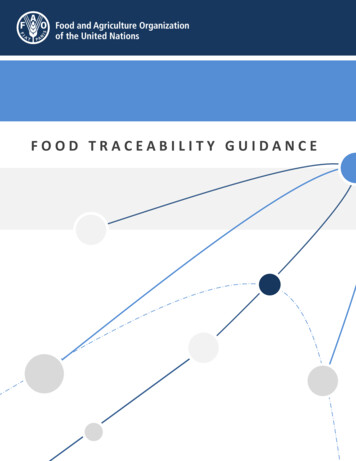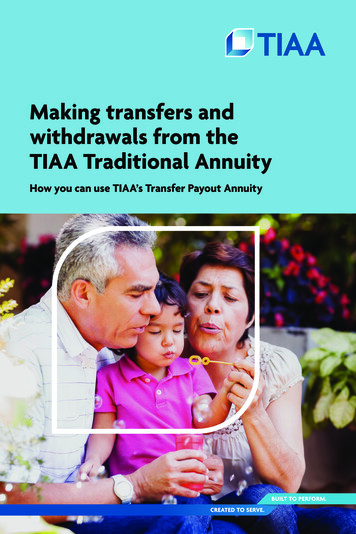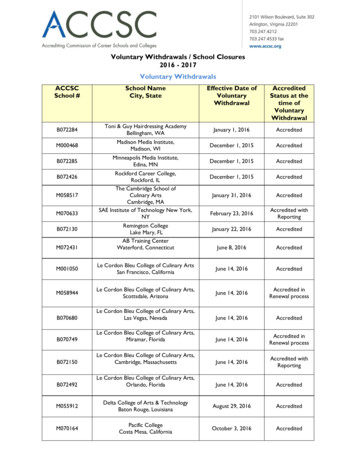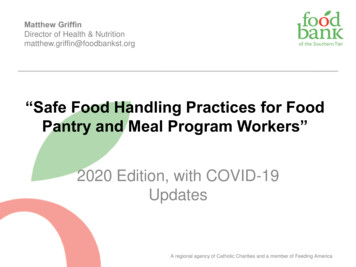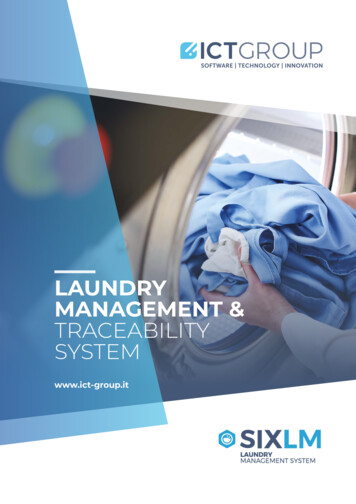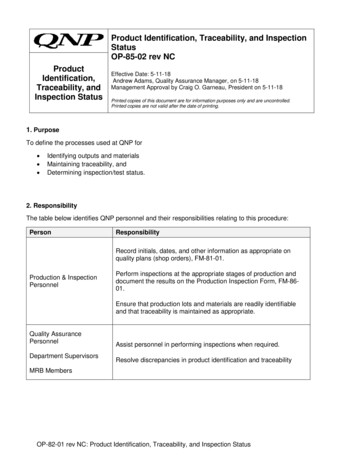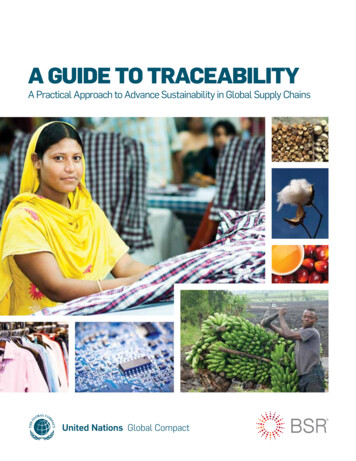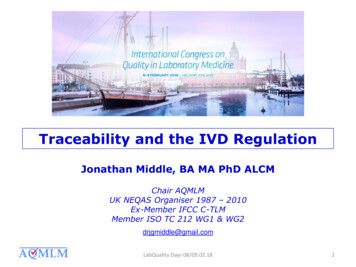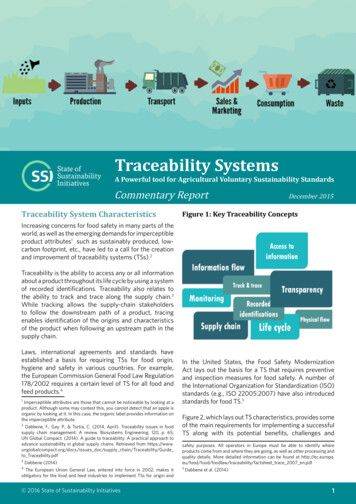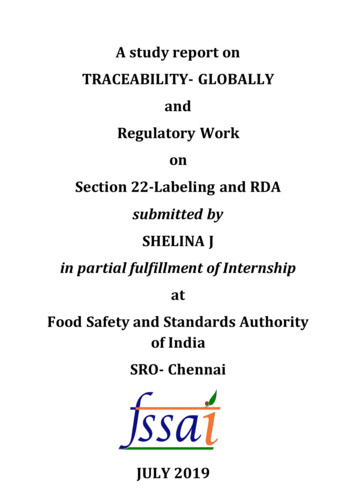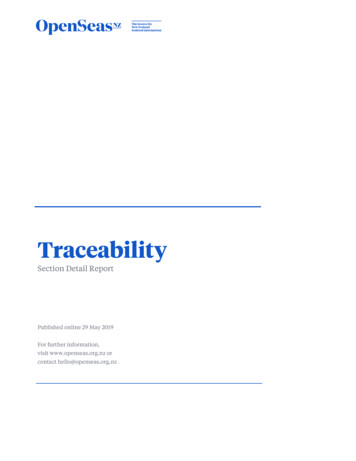
Transcription
Guidance onFood Traceability,Withdrawals andRecalls within theUK Food IndustryMarch 2019
For queries about this guidance, including if you require the information in an alternative formatsuch as audio, large print or Braille please contact:For Scotland:Email: incidents@fss.scotTel: 01224 285 138For England, Wales and Northern Ireland:Email: foodincidents@food.gov.ukTel: 020 7276 8448
SummaryIntended audience Food business operators (FBOs)UK food enforcement authoritiesWhich UK nations does thiscover?England, Wales, Scotland and Northern IrelandPurposeThe purpose of this guidance is to assist FBOs tocomply with food law and to provide guidance on roles,responsibilities and actions to take during food safetywithdrawals and recalls.Legal status:This guidance sets out the legal requirements ofRegulation (EC) No.178/2002 and associated foodlegislation. The guidance also includes best practiceguidance.Key words Review dateFood lawFood withdrawalsFood recallsFood safetyTraceabilityMarch 2020Guidance on Food Traceability, Withdrawals and Recalls within the UK Food Industry1
Revision historyThis guidance follows the Government Code of Practice on Guidance. If you believethis guidance breaches the Code for any reason, please let us know by emailingbetterregulation@food.gov.uk. If you have any comments on the guidance itself,please call us using the contact number on page 2.RevisionNo.2RevisiondatePurpose of revision and paragraphnumberGuidance on Food Traceability, Withdrawals and Recalls within the UK Food IndustryRevised by
Summary1Revision history2Introduction5Intended audience5Purpose and scope of guidance6Legal status of guidance6EU Exit7De initions7Traceability8Key steps in developing food traceability systemsMaking a decision to withdraw or recall food91113Performing a risk assessmentPlanning for a food withdrawal/recallInitiating and managing a food withdrawal/recall1414Information gathering15Notification procedures15Monitoring progress of a food withdrawal/recall16Handling of unsafe food16Roles and responsibilities of those involved ina withdrawal/recall19FBOs initiating a food withdrawal/recall20Non-retail FBOs receiving notification of a food withdrawal/recall21Retail FBOs receiving notification of a food withdrawal/recall (includingcatering businesses selling prepacked food)22Caterers receiving notification of a food withdrawal23Enforcement authorities23Primary and Home authorities (where applicable)24Central competent authorities (FSA and FSS)24Consumer, allergy and patient support organisations25Guidance on Food Traceability, Withdrawals and Recalls within the UK Food Industry3
Contents4Annexe A: Food Recalls Steering Group and Working Group Members26Annexe B: Definitions27Annexe C: Specific food traceability requirements30Annexe D: Example of microbiological risk assessment considerations Annexe E:32Planning for a food withdrawal/recall34Annexe E(i): Example contacts template37Annexe E(ii): Example food incident key decision log38Annexe F: Example template for notifying the enforcement authority39Annexe G: Business-to-business communications for food safety withdrawalsand recalls across the supply chain42Annexe H: Key principles and best practice template for accurate and effectiveconsumer recall notifications47Annexe I: Background to root cause analysis53Guidance on Food Traceability, Withdrawals and Recalls within the UK Food Industry
Introduction1 This guidance has been produced by the Food Standards Agency (FSA) with FoodStandards Scotland (FSS), in association with members of working groups and agoverning steering group, established as part of a UK project, to: develop comprehensive UK guidance to clarify the roles, responsibilities andexpectations of the key players involved in food withdrawals and recalls in the UK improve the accessibility and consistency of food recall information directed at consumers enhance business to business communications about food recalls and withdrawals and establish guidance on root cause analysis (RCA) procedures to be used by industry inthe event of food withdrawals and recalls2 It replaces the FSA Guidance Notes for Food Business Operators on Food Safety,Traceability, Product Withdrawal and Recall produced in 20071.3 Project group members included representatives from the food industry, trade bodies,consumer, allergy and patient support organisations and enforcement authorities (seeAnnexe A for membership).4 FBOs are responsible for the safety of the food which they produce, distribute, store orsell, in particular FBOs must: not place unsafe food on the market comply with food law in the production, distribution, storage and sale of food be able to trace the suppliers of their food and the business customers to whom theyhave supplied the food (i.e. one step back and one step forward) andremove unsafe food from the market should a food safety incident arise5 FBOs should therefore have adequate traceability and food withdrawal/recall systems inplace as part of their Food Safety Management System to fulfil these requirements. FBOsmay wish to seek advice from the enforcement authority with whom they are registered orapproved, and/or their Primary/Home authority for assurance that any system developedfor this purpose is appropriate and compliant.Intended audience6 The intended audience of this guidance is FBOs and UK food safety enforcementauthorities, as outlined in the definitions.1 document/fsa1782002guidance.pdfGuidance on Food Traceability, Withdrawals and Recalls within the UK Food Industry5
Purpose and scope of guidancePurpose and scope of guidance7 The purpose of this guidance is to support FBOs and UK food safety enforcementauthorities in establishing and implementing effective food withdrawal/recall systems torespond to food safety incidents. The guidance applies to all FBOs and aims to clarifyand, where appropriate, standardise procedures to identify and remove unsafe food fromthe market.8 The guidance outlines food law requirements and clarifies the roles, responsibilities andexpectations of the key stakeholders involved in the withdrawal/recall of unsafe food in the UK.9 The guidance sets out the requirements in relation to food safety incidents, in accordancewith Regulation (EC) No. 178/2002. It does not include animal feed (including pet food).However, FBOs may wish to adopt the principles within this guidance when dealing withnon-safety (non-compliant) related food, food contact materials, or animal feed (includingpet food) incidents.Legal status of guidance10 This guidance has been produced to explain the legal requirements of Regulation (EC)No.178/20022 in relation to food safety traceability, withdrawals and recalls and howcompliance may be achieved. Best practice guidance has also been included. You are notrequired by law to follow best practice guidance.11 The guidance is laid out in a format designed to allow businesses to consider theirprocesses and whether their current or proposed arrangements comply with food law. It islaid out in the following format: ‘The law’ – this quotes the relevant specific legal requirements. It is detailed at the startof the relevant section‘How to comply with the law’ – this outlines FSA and FSS guidance on how to comply withthe law. Businesses may take a different approach to achieve compliance with the law, butit is advisable to discuss any alternative approach with enforcement authorities in advance‘Best practice’ – this outlines examples of good practices that businesses may want toimplement. Businesses are not required by law to follow best practice. All guidance onbest practice is identified in boxes with a heading of Best Practice:Best PracticeAll best practice guidance is clearly identified within this document by this style of format.2 L/?uri CELEX:02002R0178-20180701&qid 1530528430965&from EN6Guidance on Food Traceability, Withdrawals and Recalls within the UK Food Industry
EU Exit12. This guidance should be read in conjunction with Regulation (EC) No. 178/2002, theFood Safety Act 19903, associated domestic food law legislation4, EU Food HygieneRegulations5, domestic food hygiene regulations6 and other specific legislation andguidance relating to food traceability and safety.13 Guidance on legal requirements in this document cannot cover every situation andFBOs may need to refer to the relevant legislation to see how it applies in any givencircumstance. FBOs with specific queries may wish to seek advice from their enforcementauthorities or seek their own legal advice.EU Exit14 References in this guidance to EU law should be read, where necessary, as references toretained EU law as amended under the European Union (Withdrawal) Act 2018.15 Guidance as to how that Act affects EU law is beyond the scope of this publication. FBOsand enforcement authorities are strongly encouraged to seek independent legal adviceabout their rights and obligations in connection with the Act, and EU Exit generally.Definitions16 A list of definitions of the key terms used throughout this guidance is provided in Annexe B.3 nts. Equivalent legislation in NI is The Food Safety (NI) Order1991 – ts/made4 The General Food Law Regulations 2004 in Scotland and Wales – nts/made the Food Safety and Hygiene (England) Regulations 2013 in England – ule/9/made and the General Food Regulations (NI) 2004 in NI – nts/made5 Regulation (EC) No.s 852/2004 – /?uri CELEX:02004R085220090420&qid 1545304105490&from ENRegulation (EC) No. 853/2004 – /?uri CELEX:02004R0853-20171121&qid 1545304143432&from ENRegulation (EC) No. 854/2004 – /?uri CELEX:02004R0854-20170101&qid 1545304202861&from ENRegulation (EC) No. 2073/2005 – /?uri CELEX:02005R2073-20180101&qid 1545304256862&from EN6 The Food Safety and Hygiene (England) Regulations 2013 – http://www.legislation.gov.uk/uksi/2013/2996,the Food Hygiene (Wales) Regulations 2006 – http://www.legislation.gov.uk/wsi/2006/31/made, the FoodHygiene Regulations (Northern Ireland) 2006 – /made and theFood Hygiene (Scotland) Regulations 2006 – madeGuidance on Food Traceability, Withdrawals and Recalls within the UK Food Industry7
TraceabilityThe lawLegalrequirements:Article 18 ofRegulation (EC)No. 178/2002The traceability of food, food-producing animals, and any othersubstance intended to be, or expected to be, incorporated into afood shall be established at all stages of production, processingand distribution.Food business operators shall be able to identify any person fromwhom they have been supplied with a food, , a food-producinganimal, or any substance intended to be, or expected to be,incorporated into a food . To this end, such operators shall have inplace systems and procedures which allow for this information to bemade available to the competent authorities on demand.Food business operators shall have in place systems andprocedures to identify the other businesses to which their productshave been supplied. This information shall be made available to thecompetent authorities on demand.Food which is placed on the market or is likely to be placedon the market in the Community shall be adequately labelledor identified to facilitate its traceability, through relevantdocumentation or information in accordance with the relevantrequirements of more specific provisions.How to comply with the law17 Each segment of the supply chain must be able to trace all the foods received by them andsupplied by them (one step back and one step forward). This will include being able totrace, as required, the ingredients used to produce finished products.18 In relation to food law, food retailers, including caterers, are not required to keeptraceability information relating to sales to the final consumer (since consumers are notfood businesses). Where a retailer knows that it is supplying directly to another foodbusiness, e.g. a catering outlet, traceability requirements must be adhered to.19 Business actions necessary to comply with the law will depend on the individual businessactivities, and what is achievable for the business, but effective traceability allowsfor effective and efficient corrective actions to be taken should a food safety incidentoccur. It enables FBOs to target any withdrawals and/or recalls, to give information toenforcement authorities and can help minimise the level of disruption and scale of thewithdrawal/recall to the business.8Guidance on Food Traceability, Withdrawals and Recalls within the UK Food Industry
Traceability7Key steps in developing food traceability systemsStep 1. The systemThe FBO’s system must be able to trace food purchased from suppliers and sold tobusiness customers (this does not include food that is sold directly to the consumer).Step 2. Defining batches of foodDefining batches of food is essential for good traceability and may help limit theamount of food to be withdrawn/recalled. In the event of a food safety incident,Regulation (EC) No. 178/2002 considers a whole batch, lot or consignment unsafeunless it can be demonstrated otherwise.Step 3. Traceability informationTraceability information for food one step back and one step forward in the supplychain is required by law. The following information should be available:name and address of supplier/business customer (food retailers, includingcaterers, are notrequire
The traceability of food, food-producing animals, and any other substance intended to be, or expected to be, incorporated into a . food shall be established at all stages of production, processing and distribution. Food business operators shall be able to identify any person from whom they have been supplied with a food, , a food-producing . animal, or any substance intended to be .
